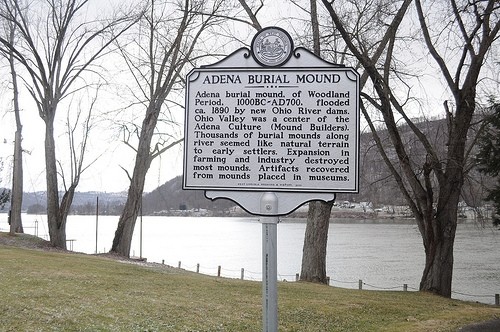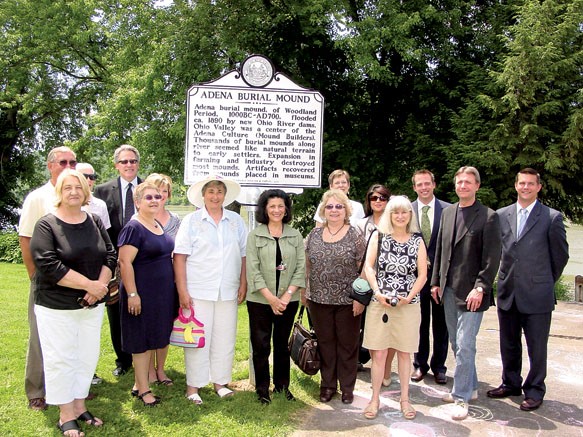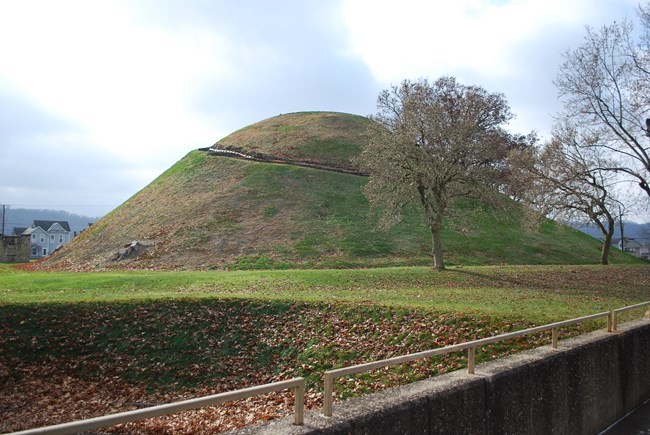Adena Burial Mound Historical Marker
Introduction
Text-to-speech Audio
Images
Adena Burial Mound Historic Marker

Adena Burian Mound Historic Marker Dedication, July 2011

Greave Creek Mound in Moundsville, WV (Marshall County)

Backstory and Context
Text-to-speech Audio
The Adena was a prehistoric, mound-building culture shared among a variety of peoples in the wider Ohio River Valley, including its tributaries in western West Virginia. The Adena culture dominated the region from approximately 1000 to 200 BCE (an archeological era known as the Woodland Period). The Adena were ultimately eclipsed by the Hopewell culture, who continued the mound-building tradition of the Adena.
With no written legacy, our fragmentary and limited knowledge of the Adena comes from archeological record. The Adena were primarily hunter-gatherers, although they practiced limited agriculture as well. Their villages usually centered on flat areas near major rivers, and they moved their villages every few years. They enjoyed wide-ranging trade networks across the eastern half of North America, including copper from the Upper Midwest, mica and ceramics from Appalachia, and shells from the Gulf Coast. The most notable features of the Adena culture, however, were their mounds. The Adena built large burial (or mortuary) mounds for prominent men and women, which often contained multiple chambers. They also built geometric earthworks that may have served ceremonial purposes.
The Adena were prolific mound-builders, with dozens of mounds stretched across Indiana, Ohio, Kentucky, and West Virginia. Several prominent Adena mounds dot the northwestern counties of West Virginia. Most notable is the Grave Creek Mound in Moundsville, West Virginia (the town's name derives from the mound), one of the largest extant Adena mounds. But also north of New Martinsville in Marshall County were the Cresap, Natrium, and Welcome Mounds, which stood about 10-15 feet high. These mounds were unfortunately destroyed during 20th century agricultural and industrial projects.
In recent years, local citizen Denise Nielson Tackett determined that an Adena mound similar to the Cresap, Natrium, and Welcome Mounds lay submerged under the waters of the Ohio River flowing aside New Martinsville. The flooded mound lies under the river near North and McEldowney Streets. In July 2011, a new state historic marker was dedicated to the Adena mound in downtown New Martinsville. As Denise Tackett noted, "The great mound building cultures of the U.S. are hardly known outside of academic and archeology circles. As the center of Adena Culture, this area should identify sites of interest and make efforts to introduce them to and inform the public about them."
Sources
1. "Mound Will Be Marked With Historical Sign." June 29, 2011. Wetzel Chronicle. Web. Accessed July 27, 2020. http://www.wetzelchronicle.com/page/content.detail/id/504869/Mound-Will-Be-Marked-With-Historical-Sign.html
2. Amy Witschey, "Historical Marker Dedicated." July 6, 2011. Wetzel Chronicle. Web. Accessed July 27, 2020. http://www.wetzelchronicle.com/page/content.detail/id/504901.html
3. Frank M. Setzler. "Welcome Mound and the Effigy Pipes of the Adena People." Proceedings of the United States National Museum. Smithsonian Institution, Washington, D.C. Vol. 112, No. 3441. 1960. Digitized. http://www.wvgenweb.org/marshall/cemetery/locust-adenamounds.pdf
4. James P. Fenton. "Adena." November 15, 2016. e-WV: The West Virginia Encyclopedia. Web. Accessed July 27, 2020. https://www.wvencyclopedia.org/articles/21
5. Patrick D. Trader. "Mound Builders." August 15, 2019. e-WV: The West Virginia Encyclopedia. Web. Accessed July 27, 2020. https://www.wvencyclopedia.org/articles/1424
6. William S. Webb and Charles E. Snow. The Adena People. Knoxville: University of Tennessee Press, 1974.
7. Susan L. Woodward and Jerry N. McDonald. Indian Mounds of the Middle Ohio Valley: A Guide to Adena and Hopewell Sites. Newark, OH: McDonald and Woodward Publishing, 1986.
Nessa Chan, Historical Marker Database: https://www.hmdb.org/m.asp?m=64099
Wetzel Chronicle, http://www.wetzelchronicle.com/page/content.detail/id/504901.html
Rhonda Humphreys, https://www.nps.gov/articles/grave-creek-mound.htm
